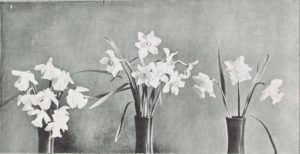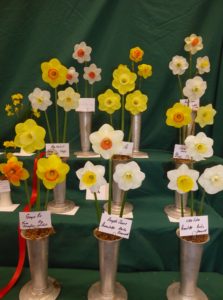The Cambridge Daffodil Show
-
This article was written by Clive Denton. He recently published One Hundred Years of Cambridge Daffodil Shows. Sourcing archives for Clive was a fascinating process for Museum staff. A copy of his book is held at the museum.
The Cambridge Daffodil Show was one of many such flower shows that flourished in almost every city, town and village throughout New Zealand in the 20th century. These flower shows were usually organised by the local church or Horticultural Society. At the spring shows held in August/September, daffodils would be the in-season flower, but by no means the only display vying for public attention. There would be a host of other flowers, fruits, vegetables, preserves, baking, needle crafts and stalls. These shows performed an important social function in the community, particularly for isolated rural folk. They were also important fundraisers for the churches.
Sources of Information
The first Cambridge Spring Flower Show was held in 1907. In researching this institution, two important sources of information emerged. The museum held a minute book that carefully recorded meetings and show reports from the formation of the Cambridge Daffodil Society in 1912 until 1968. Another minute book was in the care of the Northern Daffodil Club and the diligent record keeping was continued until the Society went into recess in 1991. In 1996, members of the Northern Daffodil Club reinstated the show, which continued until its last show in the Cambridge Town Hall in 2007. Both minute books are now in the safekeeping of the Cambridge Museum.
Over the years, the Cambridge Daffodil Society made full use of the local newspapers for the reporting of their shows. In contrast to the matter-of-fact minutes, these reports provided additional information. More importantly, they gave an insight into personalities and the nature of the events. The internet site Papers Past is a useful source of information for earlier newspapers up to about 1950. Whilst you can highlight your key words, trawling through the information can be a bit tedious. Digital NZ is a good source of photographs, although some are difficult to download. You will find the later editions of the Cambridge Independent at the museum all beautifully bound in a hard cover. I knew the dates of events I wanted (day/month/year) so finding information was very easy.
The Daffodil Show
In 1907, the young women of the Presbyterian bible class organised a spring flower show to raise funds to extend the church hall to better accommodate the bible and Sunday school classes. There was an imaginative array of flowers and entertainments. The mayor at the time, Mr W F Buckland, an enthusiastic horticulturalist, wrote the daffodil schedule, entered numerous prize-winning flowers and donated bulbs to further promote the growing of daffodils. The show was a great success and raised £110 for the church. The show was repeated in 1908 and 1909. The rambunctious, take-no-prisoners Mayor worked beside the teenage girls, even though they seemed the only ones interested in the daffodils. Mr Buckland did manage to find something to growl about to the girls on each occasion, however!

Daffodils on display at the Cambridge Daffodil Show, 1910
In 1910, the show shifted from the Alexandra Hall to the new Town Hall (another Mayor Buckland project). The prestige of this move seemed to result in an increased interest and involvement, and by 1912 the Presbyterian Church had called a congregational meeting to form a properly constituted society to run the spring show. Its name became the Cambridge Daffodil Society. The committee was to be selected from members of the congregation. Mr Buckland was a member of another church, so Mr A Hopkirk became the President of the Society.
Other insights
People’s involvement in hobbies and clubs often provides an escape from the pressures and concerns of wider society. They report on their activities in a rather pragmatic way which seems only of interest to those involved. However, reading between the lines, looking for patterns and thinking about isolated comments in the context of the day will often provide insights into the society in which they lived.
With the outbreak of WWI, the Society pledged all of their show profits “to the relief of local distress.” Although there was a country-wide enthusiasm for patriotic fundraising, mostly it went to the wider support of Empire or soldiers overseas. The Te Waikato sanatorium on Maungakawa had become a hospital for returned soldiers so the local Daffodil Society funds went there.
In 1918, the daffodil show was lucky to get the Town Hall, as the rose show due in November had been cancelled. This comment gives rise to an investigation of the influenza epidemic when the Town Hall was being used as a hospital. The Society was indeed impacted, losing two young women who volunteered to work there.
Early flower shows were two-day affairs and entertainment went on into the night. “A full hall enjoyed Mr MacDonald’s sword dance and sailors horn pipe, a musical selection on concertina by Mr Martin, Mr Hauster’s dramatic sketches gave much merriment and the Hautapu school boys gave a spirited and clever Maori haka.”
In 1928, a world renowned daffodil specialist Mr Wilson from Ireland visited Mr Hopkirk’s garden in Grosvenor Street where there was a ¾ acre of daffodil gardens and a further area of naturalised bulbs amongst the trees. Mr Wilson was impressed.
In the early 1930s, the Treasurer reported “in spite of a difficult year there was a £16 profit for the church.” This halving of the profit continued for the next three years. The show was held in the less than adequate Peace Hall which the church had just built. It saved on rental. “In the novice section flowers must be from bulbs of less than 2/-.” This was rescinded after the depression.
In 1939 “mainly due to restrictions on petrol” the show was cancelled for this and the remaining war years. It made a rather tentative restart in 1946, restricted to novice growers only. The President appealed for younger members from the congregation to help run the show. In spite of the tentative restart, the show thrived during the next 30 years, although the deaths of many of the original members were recorded.
The Cambridge daffodil show was never restricted to just local growers. Indeed the first show in 1907 was to have received flowers from Mrs Johnston of Remuera. Unfortunately they went astray on the train and ended up in Rotorua. The 1926 show records entries from Te Awamutu, Hamilton, Auckland and Thames. In 1913, a prominent grower Mr Weightman from Fielding attended. It is probably fair to say that at this, the wettest time of the year, there would have been few passable roads, particularly through the Rangitikei and King Country regions. Mr Weightman’s preferred mode of transport was probably the train. He could have boarded it late in the evening at Fielding, travelled through the night and arrived early in the morning at Hamilton, transferred to the Cambridge branch line, got off at the station and walked to the Hall.

Advert for Cambridge Daffodil Show, 1923
Later decades
In the decade from 1970 to 1980 the Cambridge daffodil show reached its zenith. This high point seems to have come at a time when growing and showing of flowers was popular throughout New Zealand. Gardening was the country’s favourite fascination. It was a time of extravagant and ambitious garden shows. Also during this time, handcrafts were a popular pastime. Cambridge Daffodil Show records indicate they were aware of the pulling power of this trend. Each year a craft display was included, for example Pottery, Wool Craft and Spinning, Quilting, Antiques and Floral Art.
1987 was a milestone year for the club. It was their 75th anniversary and the show was to be held in the new Trinity Church complex in Bryce Street. Although the complex had been completed some years previous, the Daffodil Society was concerned it would not be suitable. These concerns were soon dispelled; the show was a great success, so much so that next year the Northern Daffodil Club joined forces with the locals and in this new venue held the first National Show ever in Cambridge. There were 911 visitors to the show.
By the 1990s, flower shows had become the interest of dedicated hobbyists, semi-professionals and professional growers. Outside exhibitors were providing the daffodils and the locals were doing the work. This workload on a small number of older parishioners was the final straw for the Cambridge show. The last show under the Church-run Society was in 1992. The Northern Daffodil Club was unable to respond to a last-minute plea to take over the running of the show. Had the 1912 resolution not restricted the Society to the Church congregation, then maybe other enthusiastic daffodil growers in the Waikato may have coalesced into the Cambridge Daffodil Society, rather than forming their own club in 1970.

Daffodils on show at Cambridge Daffodil Show, 2010
Several years later, in 1996, the Northern Daffodil Club did restart the Cambridge Show. They held the last show in the Town Hall in 2007.
In 2023, a second National Daffodil Show was held in the Cambridge Town Hall. A report in the most recent New Zealand Daffodil Bulletin states: “The Northern Daffodil Club offered to host the National Show in the Cambridge Town Hall. What a great venue and location it turned out to be. Cambridge was a beautiful little town for the occasion.”
